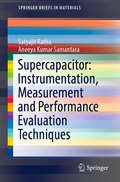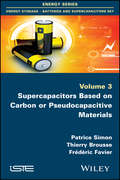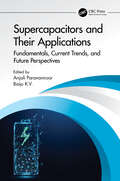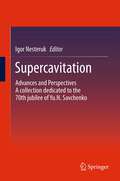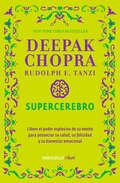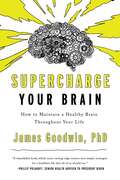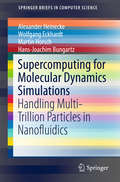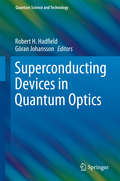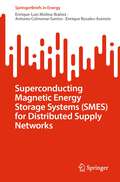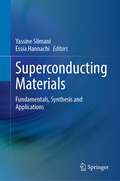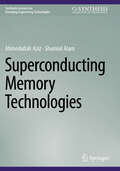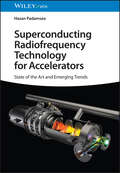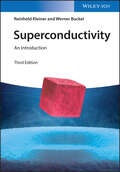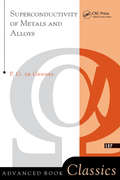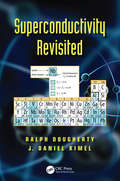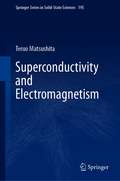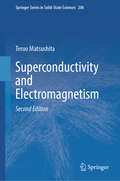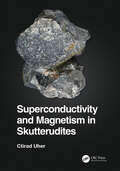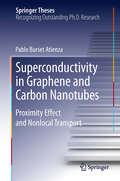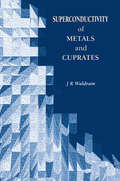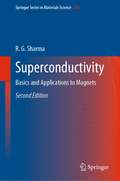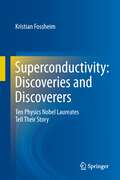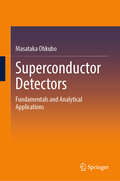- Table View
- List View
Supercapacitor: Instrumentation, Measurement and Performance Evaluation Techniques (SpringerBriefs in Materials)
by Satyajit Ratha Aneeya Kumar SamantaraThis book discusses the instrumentation of supercapacitors, various measurement procedures and the techniques used for the performance evaluation, to help determine the appropriate methodology for the evaluation of a supercapacitor device and also to identify the inconsistencies between the device performance and electrode material properties. As a promising energy storage option, supercapacitors need to be readied for commercialization rather than confined within the niche of academic research. This book also assists in the formulation of strict performance guidelines aided by realistic evaluation techniques, so that these devices can be made available to society through industrial production. As such it is an important read not only for academicians and researchers, but also for industry and policymakers.
Supercapacitors Based on Carbon or Pseudocapacitive Materials
by Frédéric Favier Patrice Simon Thierry BrousseElectrochemical capacitors are electrochemical energy storage devices able to quickly deliver or store large quantities of energy. They have stimulated numerous innovations throughout the last 20 years and are now implemented in many fields. Supercapacitors Based on Carbon or Pseudocapacitive Materials provides the scientific basis for a better understanding of the characteristics and performance of electrochemical capacitors based on electrochemical double layer electrodes or pseudocapacitive materials, as well as providing information on the design and conception of new devices such as lithium-ion capacitors. This book details the various applications of supercapacitors, ranging from power electronics and stationary use, to transportation (hybrid vehicles, trams, planes, etc.). They are increasingly used in the automotive sector, especially as part of stop/start systems that have allowed for energy recovery through braking and reduced fuel consumption.
Supercapacitors and Their Applications: Fundamentals, Current Trends, and Future Perspectives
by Anjali Paravannoor and Baiju K. V.Owing to their high-power density, long life, and environmental compatibility, supercapacitors are emerging as one of the promising storage technologies, but with challenges around energy and power requirements for specific applications. This book focusses on supercapacitors including details on classification, charge storage mechanisms, related kinetics, and thermodynamics. Materials used as electrodes, electrolytes, and separators, procedures followed, characterization methods, and modeling are covered, along with emphasis on related applications. Features: Provides an in-depth look at supercapacitors, including their working concepts and design Reviews detailed explanation of various characterization and modeling techniques Give special focus to the application of supercapacitors in major areas of environmental as well as social importance Covers cyclic voltammetry, charging–discharging curves, and electrochemical impedance spectroscopy as characterization techniques Includes a detailed chapter on historical perspectives on the evolution of supercapacitors This book is aimed at researchers and graduate students in materials science and engineering, nanotechnology, chemistry in batteries, and physics.
Supercavitation
by Igor NesterukThis collection is dedicated to the 70th jubilee of Yu. N. Savchenko, and presents experimental, theoretical, and numerical investigations written by an international group of well-known authors. The contributions solve very important problems of the high-speed hydrodynamics,such as supersonic motion in water, drag diminishing, dynamics and stability of supercavitating vehicles, water entry and hydrodynamic performances of hydrofoils, ventilated cavities after a disc and under the ship bottom. The book is written for researches, scientists, engineers, and students interested in problems of hydromechanics.
Supercerebro: Libere el poder explosivo de su mente para potenciar su salud, su felicidad y su
by Deepak ChopraEste revolucionario y novedoso manual le mostrará cómo usar su cerebro como portal hacia la salud, la felicidad y el crecimiento espiritual. En contraste con el cerebro estándar, que sólo desempeña tareas cotidianas, Chopra y Tanzi proponen que el cerebro puede aprender a superar sus limitaciones actuales. Supercerebro le explica cómo hacerlo a través de los descubrimientos científicos de vanguardia y la percepción espiritual, del derrumbamiento de los cinco mitos más comunes sobre el cerebro que limitan su potencial y de la implementación de métodos para: -Usar su cerebro, en vez de permitir que él lo use a usted. -Desarrollar el estilo de vida ideal para tener un cerebro saludable. -Reducir los riesgos del envejecimiento. -Fomentar la felicidad y el bienestar por medio de la conexión entre mente y cuerpo. -Acceder al cerebro iluminado, que es el portal para la libertad y la dicha. -Sobreponerse a los retos más comunes, como la pérdida de memoria, la depresión, la ansiedad y la obesidad. Su cerebro es capaz de sanar de forma extraordinaria y de reconfigurarse de forma constante. Si establece una nueva relación con él, transformará su vida. En Supercerebro, Chopra y Tanzi lo guiarán a través de un fascinante viaje que pronostica un salto en la evolución humana. El cerebro no es sólo el don más increíble que nos ha dado la naturaleza, sino que también es el portal para un futuro ilimitado que puede comenzar a vivir hoy mismo. "Este par de especialistas de talla internacional combina su conocimiento para dar vida, en un elegante texto que nos permitirá mantener la juventud cerebral, a la cautivadora historia de nuestro cerebro." Dr. Mehmet Oz
Supercharge Your Brain: How to Maintain a Healthy Brain Throughout Your Life
by James GoodwinThe definitive guide to keeping your brain healthy for a long and lucid life, by one of the world's leading scientists in the field of brain health and ageing.The brain is our most vital and complex organ. It controls and coordinates our actions, thoughts and interactions with the world around us. It is the source of personality, of our sense of self, and it shapes every aspect of our human experience. Yet most of us know precious little about how our brains actually work, or what we can do to optimise their performance. Whilst cognitive decline is the biggest long-term health worry for many of us, practical knowledge of how to look after our brain is thin on the ground. In this ground-breaking new book, leading expert Professor James Goodwin explains how simple strategies concerning exercise, diet, social life, and sleep can transform your brain health paradigm, and shows how you can keep your brain youthful and stay sharp across your life. Combining the latest scientific research with insightful storytelling and practical advice, Supercharge Your Brain reveals everything you need to know about how your brain functions, and what you can do to keep it in peak condition.
Supercharge, Invasion, and Mudcake Growth in Downhole Applications (Advances in Petroleum Engineering)
by Yongren Feng Yanmin Zhou Wilson Chin Tao Lu Xiaofei QinMysterious "supercharge effects," encountered in formation testing pressure transient analysis, and reservoir invasion, mudcake growth, dynamic filtration, stuck-pipe remediation, and so on, are often discussed in contrasting petrophysical versus drilling contexts. However, these effects are physically coupled and intricately related. The authors focus on a comprehensive formulation, provide solutions for different specialized limits, and develop applications that illustrate how the central ideas can be used in seemingly unrelated disciplines. This approach contributes to a firm understanding of logging and drilling principles. Fortran source code, furnished where applicable, is listed together with recently developed software applications and conveniently summarized throughout the book. In addition, common (incorrect) methods used in the industry are re-analyzed and replaced with more accurate models, which are then used to address challenging field objectives. Sophisticated mathematics is explained in "down to earth" terms, but empirical validations, in this case through Catscan experiments, are used to "keep predictions honest." Similarly, early-time, low mobility, permeability prediction models used in formation testing, several invented by one of the authors, are extended to handle supercharge effects in overbalanced drilling and near-well pressure deficits encountered in underbalanced drilling. These methods are also motivated by reality. For instance, overpressures of 2,000 psi and underpressures near 500 psi are routinely reported in field work, thus imparting a special significance to the methods reported in the book. This new volume discusses old problems and modern challenges, formulates and develops advanced models applicable to both drilling and petrophysical objectives. The presentation focuses on central unifying physical models which are carefully formulated and mathematically solved. The wealth of applications examples and supporting software discussed provides readers with a unified focus behind daily work activities, emphasizing common features and themes rather than unrelated methods and work flows. This comprehensive book is "must" reading for every petroleum engineer.
Supercomputing for Molecular Dynamics Simulations
by Alexander Heinecke Wolfgang Eckhardt Martin Horsch Hans-Joachim BungartzThis work presents modern implementations of relevant molecular dynamics algorithms using ls1 mardyn, a simulation program for engineering applications. The text focuses strictly on HPC-related aspects, covering implementation on HPC architectures, taking Intel Xeon and Intel Xeon Phi clusters as representatives of current platforms. The work describes distributed and shared-memory parallelization on these platforms, including load balancing, with a particular focus on the efficient implementation of the compute kernels. The text also discusses the software-architecture of the resulting code.
Superconducting Devices in Quantum Optics
by Robert H. Hadfield Göran JohanssonThis book presents the basics and applications of superconducting devices in quantum optics. Over the past decade, superconducting devices have risen to prominence in the arena of quantum optics and quantum information processing. Superconducting detectors provide unparalleled performance for the detection of infrared photons in quantum cryptography, enable fundamental advances in quantum optics, and provide a direct route to on-chip optical quantum information processing. Superconducting circuits based on Josephson junctions provide a blueprint for scalable quantum information processing as well as opening up a new regime for quantum optics at microwave wavelengths. With recent advances in coherent conversion between telecom and microwave frequencies, it is possible to envisage the marriage of these approaches, as superconducting qubits are embedded in long distance fiber optic communications networks. This volume, edited by two leading researchers, provides a timely compilation of contributions from top groups worldwide across this dynamic field, anticipating future advances in this domain.
Superconducting Magnetic Energy Storage Systems (SpringerBriefs in Energy)
by Antonio Colmenar-Santos Enrique Rosales-Asensio Enrique-Luis Molina-IbáñezThis book explores the potential of magnetic superconductors in storage systems, specifically focusing on superconducting magnetic energy storage (SMES) systems and using the Spanish electricity system, controlled by Red Eléctrica de España (REE), as an example.The book provides a comprehensive analysis of the economic costs associated with the manufacture and maintenance of SMES systems, as well as a regulatory analysis for their implementation in the complex Spanish electrical system. The analysis also compares this system with the regulations of other countries, providing a comprehensive case study.The book examines the possible economic and environmental benefits of using magnetic superconductors in electrical systems and provides a technical study of the use of these systems in hybrid storage systems that complement each other to optimize network performance. The study is conducted from the perspective of new distribution networks, distributed generation, and the concepts of the smart city. The book also explores potential applications and developments, such as electric vehicles.Overall, this book offers an insightful and comprehensive analysis of the potential of magnetic superconductors in storage systems. It will be an invaluable resource for researchers, engineers, and policymakers interested in the future of energy storage systems
Superconducting Materials: Fundamentals, Synthesis and Applications
by Yassine Slimani Essia HannachiThis book presents an overview of the science of superconducting materials. It covers the fundamentals and theories of superconductivity. Subjects of special interest involving mechanisms of high temperature superconductors, tunneling, transport properties, magnetic properties, critical states, vortex dynamics, etc. are present in the book. It assists as a fundamental resource on the developed methodologies and techniques involved in the synthesis, processing, and characterization of superconducting materials. The book covers numerous classes of superconducting materials including fullerenes, borides, pnictides or iron-based chalcogen superconductors ides, alloys and cuprate oxides. Their crystal structures and properties are described. Thereafter, the book focuses on the progress of the applications of superconducting materials into superconducting magnets, fusion reactors, and accelerators and other superconducting magnets. The applications also cover recent progress in superconducting wires, power generators, powerful energy storage devices, sensitive magnetometers, RF and microwave filters, fast fault current limiters, fast digital circuits, transport vehicles, and medical applications.
Superconducting Memory Technologies (Synthesis Lectures on Emerging Engineering Technologies)
by Ahmedullah Aziz Shamiul AlamThere is a lot of excitement around quantum computers that use superconducting qubits, which operate at extremely low temperatures since they are ultra-sensitive to noise. These quantum computers need a memory and control processor that can operate under cryogenic conditions. Among the cryogenic memory technologies, superconducting memories are the most efficient and compatible for these purposes. They can help advance quantum computing, facilitate high-performance computing, and explore space more effectively. However, cryogenic memory technologies currently face various challenges. This book discusses the latest advancements in superconducting memory technologies. It covers four main types of superconducting memories: Josephson junction-based, magnetic Josephson junction-based, superconducting memristor-based, and ferroelectric superconducting quantum interference device-based memories. The book explores the background, working principles, and challenges of each of these technologies, providing a comprehensive overview of the field.
Superconducting Radiofrequency Technology for Accelerators: State of the Art and Emerging Trends
by Hasan PadamseeSuperconducting Radiofrequency Technology for Accelerators Single source reference enabling readers to understand and master state-of-the-art accelerator technology Superconducting Radiofrequency Technology for Accelerators provides a quick yet thorough overview of the key technologies for current and future accelerators, including those projected to enable breakthrough developments in materials science, nuclear and astrophysics, high energy physics, neutrino research and quantum computing. The work is divided into three sections. The first part provides a review of RF superconductivity basics, the second covers new techniques such as nitrogen doping, nitrogen infusion, oxide-free niobium, new surface treatments, and magnetic flux expulsion, high field Q slope, complemented by discussions of the physics of the improvements stemming from diagnostic techniques and surface analysis as well as from theory. The third part reviews the on-going applications of RF superconductivity in already operational facilities and those under construction such as light sources, proton accelerators, neutron and neutrino sources, ion accelerators, and crab cavity facilities. The third part discusses planned accelerator projects such as the International Linear Collider, the Future Circular Collider, the Chinese Electron Positron Collider, and the Proton Improvement Plan-III facility at Fermilab as well as exciting new developments in quantum computing using superconducting niobium cavities. Written by the leading expert in the field of radiofrequency superconductivity, Superconducting Radiofrequency Technology for Accelerators covers other sample topics such as: Fabrication and processing on Nb-based SRF structures, covering cavity fabrication, preparation, and a decade of progress in the field SRF physics, covering zero DC resistance, the Meissner effect, surface resistance and surface impedance in RF fields, and non-local response of supercurrent N-doping and residual resistance, covering trapped DC flux losses, hydride losses, and tunneling measurements Theories for anti-Q-slope, covering the Xiao theory, the Gurevich theory, non-equilibrium superconductivity, and two fluid model based on weak defects Superconducting Radiofrequency Technology for Accelerators is an essential reference for high energy physicists, power engineers, and electrical engineers who want to understand the latest developments of accelerator technology and be able to harness it to further research interest and practical applications.
Superconductivity
by Reinhold Kleiner Rudolf Huebener W. BuckelThe third edition of this proven text has been developed further in both scope and scale to reflect the potential for superconductivity in power engineering to increase efficiency in electricity transmission or engines. The landmark reference remains a comprehensive introduction to the field, covering every aspect from fundamentals to applications, and presenting the latest developments in organic superconductors, superconducting interfaces, quantum coherence, and applications in medicine and industry. Due to its precise language and numerous explanatory illustrations, it is suitable as an introductory textbook, with the level rising smoothly from chapter to chapter, such that readers can build on their newly acquired knowledge. The authors cover basic properties of superconductors and discuss stability and different material groups with reference to the latest and most promising applications, devoting the last third of the book to applications in power engineering, medicine, and low temperature physics. An extensive list of more than 350 references provides an overview of the most important publications on the topic. A unique and essential guide for students in physics and engineering, as well as a reference for more advanced researchers and young professionals.
Superconductivity Of Metals And Alloys (Advanced Books Classics Ser.)
by P. G. De GennesDrawn from the author's introductory course at the University of Orsay, Superconductivity of Metals and Alloys is intended to explain the basic knowledge of superconductivity for both experimentalists and theoreticians. These notes begin with an elementary discussion of magnetic properties of Type I and Type II superconductors. The microscopic theory is then built up in the Bogolubov language of self-consistent fields. This text provides the classic, fundamental basis for any work in the field of superconductivity.
Superconductivity Revisited
by Ralph Dougherty J. Daniel KimelWhile the macroscopic phenomenon of superconductivity is well known and in practical use worldwide, the current theoretical paradigm for superconductivity suffers from a number of limitations. For example, there is no currently accepted theoretical explanation for the pattern of superconductor critical temperatures in the periodic table. Historical
Superconductivity and Electromagnetism (Springer Series in Solid-State Sciences #195)
by Teruo MatsushitaThis book introduces readers to the characteristic features of electromagnetic phenomena in superconductivity. It first demonstrates not only that the diamagnetism in the superconductivity complies with Maxwell’s theory, which was formulated before the discovery of superconductivity, but also that the dominant E-B analogy in the electromagnetism loses perfection without the superconductivity. The book then explores flux pinning, which is responsible for the non-dissipative current in DC, leading to irreversibility in AC. Drawing on Maxwell’s work, it also proves theoretically that if there is no energy dissipation in the superconductivity caused by the break in time reversal symmetry, it contradicts the thermodynamic principle of energy conservation – something that had previously only been proved experimentally.Lastly, the book addresses the longitudinal magnetic field effect, and explains how this phenomenon leads to a new development of Maxwell’s theory. Featuring numerous appendices to help readers understand the methods of derivation of equations, this book offers students and young scientists an introduction to applied superconductivity, especially in the context of power applications. Presenting the characteristic features of electromagnetic phenomena in superconductivity from basic to advanced topics for applications, the book offers a valuable resource for graduate students and researchers studying superconductivity as well as engineers working in electric utility industry.
Superconductivity and Electromagnetism (Springer Series in Solid-State Sciences #206)
by Teruo MatsushitaThis end edition introduces to the characteristic features of electromagnetic phenomena in superconductors, demonstrating how these phenomena not only align with Maxwell&’s theory but also expand its scope. By presenting examples of peculiar magnetic behaviors, the book broadens the reader&’s understanding of electromagnetism and its implications in superconductivity. The book explores key concepts such as flux pinning, responsible for non-dissipative currents in DC systems and hysteretic irreversibility in AC systems. This irreversibility, akin to friction, arises from the instability in the motion of quantized magnetic flux lines. Additionally, the longitudinal magnetic field effect is examined, highlighting its role in advancing Maxwell&’s theory. Through these discussions, readers will gain insights into the dynamics of quantized magnetic flux lines and the critical current density, crucial for the practical application of superconductors. With numerous appendices to support the derivation of complex equations, this book is an essential resource for students and young scientists interested in applied superconductivity, particularly in power applications. It offers a comprehensive introduction to the electromagnetic phenomena in superconductors, from fundamental principles to advanced topics. Graduate students, researchers, and engineers in the electric utility industry will find this book invaluable for its detailed exploration of superconductivity and its applications. Researchers and practitioners in the field of superconductivity, as well as engineers working in the electric utility industry, will benefit from the insights provided in this book. It serves as a critical resource for understanding the electromagnetic phenomena in superconductors and their practical applications, making it a must-read for those seeking to deepen their knowledge in this area.
Superconductivity and Magnetism in Skutterudites
by Ctirad UherSuperconductivity and Magnetism in Skutterudites discusses superconducting and magnetic properties of a class of materials called skutterudites. With a brief introduction of the fundamental structural features of skutterudites, the book then provides a detailed assessment of the superconducting and magnetic properties, focusing particularly on the rare earth-filled skutterudites where a plethora of fascinating properties and ground states is realized due to interactions of the filler species with the framework ions. Such interactions underpin the exciting forms of superconductivity and magnetism, most notably realized in the exotic heavy fermion superconductor of composition PrOs4Sb12. The two main topics of superconductivity and magnetism are provided with a concise introduction of superconducting and magnetic properties so that a reader can appreciate and understand the main arguments in the text. This book would appeal to graduate students, postdoctoral students, and anyone interested in superconducting and magnetic properties of a large family of minerals called skutterudites. Key Features:• Gives a thorough account of the superconducting and magnetic properties of skutterudites. • Each topic is accompanied by introductory sections to assist in the understanding of the text. • Supported by numerous figures and all key references.
Superconductivity in Graphene and Carbon Nanotubes
by Pablo Burset AtienzaThe unique electronic band structure of graphene gives rise to remarkable properties when in contact with a superconducting electrode. In this thesis two main aspects of these junctions are analyzed: the induced superconducting proximity effect and the non-local transport properties in multi-terminal devices. For this purpose specific models are developed and studied using Green function techniques, which allow us to take into account the detailed microscopic structure of the graphene-superconductor interface. It is shown that these junctions are characterized by the appearance of bound states at subgap energies which are localized at the interface region. Furthermore it is shown that graphene-supercondutor-graphene junctions can be used to favor the splitting of Cooper pairs for the generation of non-locally entangled electron pairs. Finally, using similar techniques the thesis analyzes the transport properties of carbon nanotube devices coupled with superconducting electrodes and in graphene superlattices.
Superconductivity in Nanowires: Fabrication and Quantum Transport
by Alexey BezryadinThe importance and actuality of nanotechnology is unabated and will be for years to come. <P><P>A main challenge is to understand the various properties of certain nanostructures, and how to generate structures with specific properties for use in actual applications in Electrical Engineering and Medicine.One of the most important structures are nanowires, in particular superconducting ones. They are highly promising for future electronics, transporting current without resistance and at scales of a few nanometers. To fabricate wires to certain defined standards however, is a major challenge, and so is the investigation and understanding of these properties in the first place. A promising approach is to use carbon nanotubes as well as DNA structures as templates.Many fundamental theoretical questions are still unanswered, e.g. related to the role of quantum fluctuations. This work is tackling them and provides a detailed analysis of the transport properties of such ultrathin wires. It presents an account of theoretical models, charge transport experiments, and also conveys the latest experimental findings regarding fabrication, measurements, and theoretical analysis. In particular, it is the only available resource for the approach of using DNA and carbon nanotubes for nanowire fabrication.It is intended for graduate students and young researchers interested in nanoscale superconductivity. The readers are assumed to have knowledge of the basics of quantum mechanics and superconductivity.
Superconductivity of Metals and Cuprates
by J.R WaldramSuperconductivity of Metals and Cuprates covers the basic physics of superconductivity, both the theoretical and experimental aspects. The book concentrates on important facts and ideas, including Ginzburg-Landau equations, boundary energy, Green's function methods, and spectroscopy. Avoiding lengthy or difficult presentations of theory, it is written in a clear and lucid style with many useful, informative diagrams. The book is designed to be accessible to senior undergraduate students, making it a helpful tool for teaching superconductivity as well as serving as an introduction to those entering the field.
Superconductivity: Basics and Applications to Magnets (Springer Series in Materials Science #214)
by R.G. SharmaThis book presents the basics of superconductivity and applications of superconducting magnets. It explains the phenomenon of superconductivity, describes theories of superconductivity, and discusses type II and high-temperature cuprate superconductors. The main focus of the book is the application of superconducting magnets in accelerators, fusion reactors and other advanced applications such as nuclear magnetic resonance (NMR), magnetic resonance imaging (MRI), high-gradient magnetic separation (HGMS), and superconducting magnetic energy storage (SMES). This new and significantly extended second edition covers the state of the art in the development of novel superconductors for advanced magnet applications, as well as the production of practical superconducting wires, tapes, and ultra high current cables used for high-field magnets. It includes two new chapters each devoted to MgB2 and Fe-based superconductors, and discusses the recently developed and world record-setting 45.5-Tesla magnetic field generated by a combination of conventional and high-temperature cuprate superconducting magnets. In addition, it discusses the status and outlook of all current and future nuclear fusion reactors worldwide. The chapter on accelerators includes the ongoing efforts to build high luminosity LHC (HL-LHC), the high-energy 28 TeV LHC (HE-LHC), the future circular collider (FCC) at CERN, and the just launched electro-ion collider (EIC) at Brookhaven National Laboratory. The book is based on the long-standing experience of the author in studying superconducting materials, building magnets and delivering numerous lectures to research scholars and students. The book provides comprehensive and fundamental knowledge in the field of applied superconductivity, greatly benefiting researchers and graduate students wishing to learn more about the various aspects of superconductivity and advanced magnet applications.
Superconductivity: Discoveries and Discoverers
by Kristian FossheimThis book is about the work of 10 great scientists; who they were and are, their personal background and how they achieved their outstanding results and took their prominent place in science history. We follow one of physics and science history's most enigmatic phenomena, superconductivity, through 100 years, from its discovery in 1911 to the present, not as a history book in the usual sense, but through close ups of the leading characters and their role in that story, the Nobel laureates, who were still among us in the years 2001-2004 when the main round of interviews was carried out. Since then two of them already passed away. For each one of the 10 laureates, the author tells their story by direct quotation from interviews in their own words. Each chapter treats one laureate. The author first gives a brief account of the laureates' scientific background and main contribution. Then each laureate tells his own story in his own words. This book is unique in its approach to science history.
Superconductor Detectors: Fundamentals and Analytical Applications
by Masataka OhkuboThis book highlights how superconductor detectors that replace conventional detectors, such as semiconductor detectors and secondary electron multipliers, can overcome the fundamental limitations of certain analytical instruments. As an educational guide to students entering this field, this book begins with the history of superconductor detectors and the fundamentals on detector operation, categorizing two detection schemes of thermal detection and quantum detection. For experts, the book offers a review on the oldest and latest endeavors. Comparison between the detector physics of superconductor detectors and that of semiconductor detectors reveals unsolved issues such as quasiparticle excitation, Fano factor, average energy consumed for generating carriers, phonon loss, and spatial inhomogeneity. Instrument developers will be stimulated by the comparison of performance figures of different superconductor detector types. The novel measurement data included will contribute to a wide range of fields, such as dentistry, molecular biology, energy-saving society, planetary science, and prebiotic organic molecules in space. This book is correspondingly suitable for a broad audience in the detector research community, seeking to deepen their understanding of detector physics and its applications.
